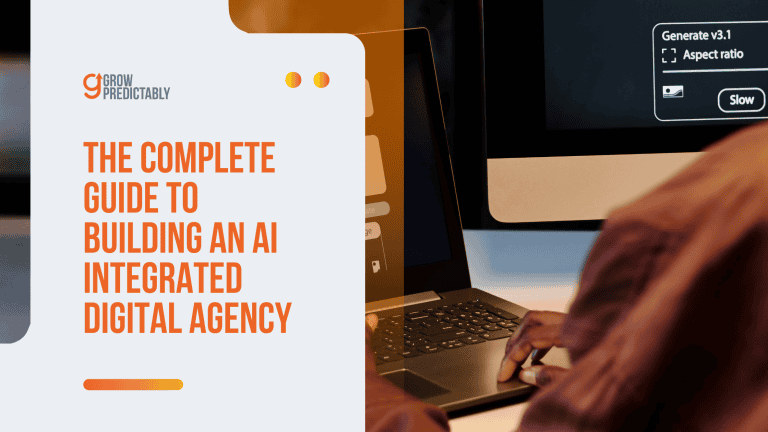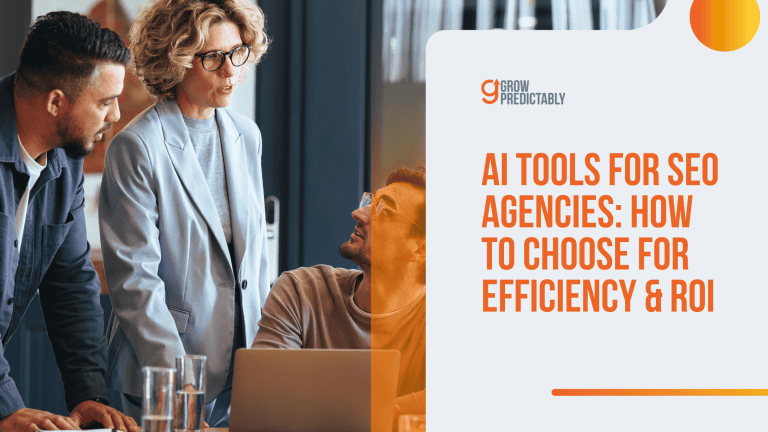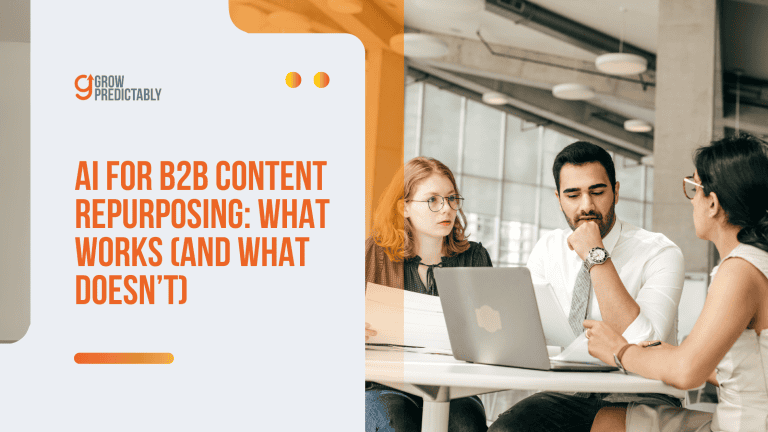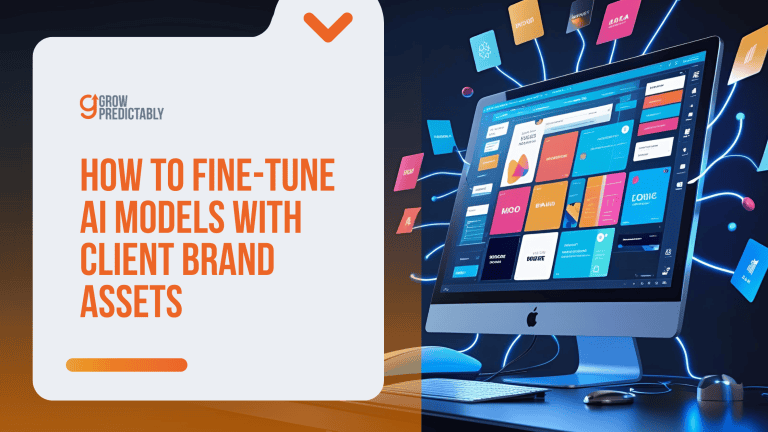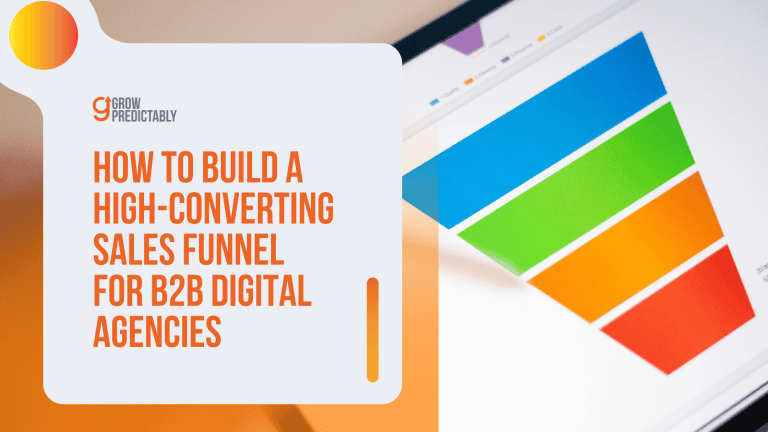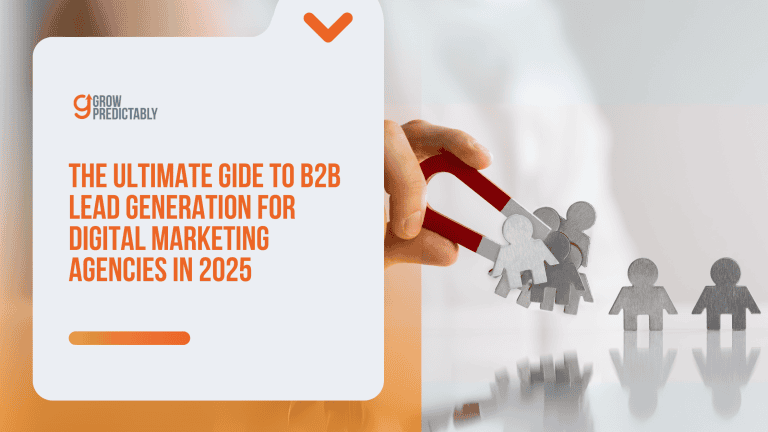Can AI Improve B2B Agency Proposal Conversion Rates? These 7 Ways Prove It Can
Your proposal game is broken, and you know it.
You’re putting in the same effort as competitors but getting crushed on conversions.
If you’re winning 20% while the competition wins 60%, they’re growing three times faster with the same work.
AI is transforming B2B marketing and B2B sales by enabling agencies to leverage AI for smarter targeting, faster lead nurturing, and data-driven strategies.
The agencies dominating aren’t better at design or pricing – they’re better at intelligence gathering, using AI in B2B to inform every step.
While you guess what prospects want, they use AI to analyze website behavior, industry reports, and social media.
The question “Can AI improve B2B agency proposal conversion rates?” has a clear answer: absolutely, especially as agencies leverage AI for better outcomes in B2B sales and marketing.
The solution isn’t working harder – it’s working with better information.
When you know exactly which pain points to address and case studies to highlight, conversion rates skyrocket.
I’ll show you seven AI implementations turning average agencies into proposal-winning machines.
Way #1: AI Speeds Up Proposal Creation Without Sacrificing Quality
Your agency probably takes 2-3 days to respond to RFPs, while your competitors are already in front of prospects.
By the time you send your beautifully crafted proposal, the client has already shortlisted three other agencies.
AI fixes this by creating your proposal drafts in 30 minutes instead of 30 hours.
It also eliminates manual data entry, automating repetitive tasks so your team can focus on higher-value activities.
If you’re not willing to get your ‘worst one ever’ out of the way, how will you possibly do better than that?”
Seth Godin
Automating the Awareness & Engagement Stages
AI analyzes your agency’s past winning proposals and current industry trends to create new drafts automatically.
This means you’re first in the client’s inbox, which puts your agency at the top of their mind before they even look at other options.
According to Harvard Business Review research, companies that respond to leads within an hour are 7 times more likely to have meaningful conversations with decision makers.
Your proposal content needs to match where each prospect sits in the Customer Value Journey.
During the Awareness stage, your proposals should educate prospects about marketing challenges they might not fully understand yet.
In the Engagement stage, you’re proving your agency understands their specific business situation.
AI handles this automatically by figuring out where each prospect is in their journey and adjusting your proposal content to match.
Here’s what this looks like for your agency:
- When a prospect downloads your “Digital Marketing Trends” report, AI creates a proposal that references the specific challenges mentioned in that report
- When they attend your webinar about lead generation, your proposal automatically emphasizes conversion optimization and sales funnel improvements
- When they visit your case study page about SaaS companies multiple times, AI highlights similar B2B success stories prominently in their proposal
- When they engage with content about paid advertising, your proposal features PPC management and ad optimization as primary services
- By segmenting prospects based on their interactions, AI can create highly targeted campaigns, ensuring each proposal is tailored to the unique needs and behaviors of each group
You’re not sending the same cookie-cutter agency proposal to every prospect.
You’re speaking directly to what made them interested in your agency in the first place.
This targeted approach makes prospects feel like you actually understand their marketing journey and challenges.
Personalizing with Customer Avatars
AI uses detailed customer avatars to shape how your agency proposals look and sound.
These avatars include company size, industry, current marketing challenges, and decision-making preferences for each type of client you work with.
AI can group customers based on demographic data and behavioral patterns, allowing for even more refined personalization by identifying high-value audience segments and tailoring proposals to their specific needs.
Your proposals end up feeling like they were written specifically for each prospect’s business, not copied from your standard agency template.
Here’s how AI personalizes your agency proposals based on different client avatars:
- SaaS startup CMOs – Proposals focus on growth hacking, conversion optimization, and scalable lead generation systems
- Traditional manufacturing VPs – Formal tone with detailed ROI projections, implementation timelines, and B2B lead generation strategies
- Healthcare practice owners – Emphasis on compliance-friendly marketing, local SEO, and patient acquisition
- E-commerce directors – Focus on conversion rate optimization, email marketing automation, and customer retention strategies
- Professional services partners – Thought leadership content, LinkedIn strategies, and referral program development
This isn’t about changing your agency’s services – it’s about presenting them in a way that connects with how each type of client thinks about their marketing challenges.
Instead of reading another generic agency pitch, prospects see content that addresses their specific industry pain points.
This personal touch increases engagement from the first read and makes prospects more likely to actually book that discovery call.
Real-Time Data Integration
AI pulls live information from your CRM and recent client interactions to make sure every proposal reflects your latest conversations.
AI leverages customer data and campaign data to ensure proposals are always relevant and up-to-date, using real-time insights to personalize recommendations and optimize strategies.
No more sending proposals with outdated company information or forgetting to mention that important point from last week’s call.
Your proposals automatically reference recent meetings, emails, and client communications.
Here’s what real-time integration does for your agency proposals:
- Budget concerns mentioned in discovery calls – AI includes cost-effective service packages and flexible retainer options
- Interest in specific marketing channels during meetings – Those services get highlighted prominently with relevant case studies
- Recent company funding or growth announcements – Proposals reference their expansion plans and scaling challenges
- Previous email exchanges about pain points – Key marketing challenges from past conversations get addressed directly
- Website behavior tracking – Service pages they visited most often influence which offerings get emphasized
This level of relevance makes prospects feel like your agency has been paying close attention to their business, not just sending the same proposal to every company.
Your proposals feel fresh and current every time.
Prospects can tell you understand their specific marketing challenges, not just throwing a generic agency pitch at them hoping something sticks.
Way #2: AI Creates Hyper-Personalized Proposals That Actually Convert
Your agency’s biggest mistake is treating every prospect the same.
You send the same proposal template to a tech startup and a law firm, then wonder why your conversion rates are stuck at 20%.
Hyper-personalization changes this by making every proposal feel like it was created specifically for that one client.
In the B2B space, hyper-personalization is essential for successful marketing campaigns, ensuring your outreach resonates with each unique audience.

Deep Avatar-Driven Customization
AI uses your Customer Avatar Canvas to dig deep into what actually keeps each prospect awake at night.
Instead of guessing what matters to them, you know exactly which pain points to hit and which benefits to emphasize.
By analyzing insights from existing customers, AI can identify patterns and preferences that help create more relevant and persuasive proposals for new prospects.
Your value proposition becomes crystal clear because it’s speaking directly to their specific situation.
Here’s how AI customizes your agency proposals based on detailed client avatars:
- SaaS company struggling with lead quality – Your proposal opens by addressing their exact frustration: “You’re getting plenty of leads, but only 2% become paying customers”
- Manufacturing company wanting digital presence – Proposal focuses on their aspiration: “Transform from traditional sales methods to generating qualified leads online 24/7”
- Healthcare practice losing patients to competitors – Addresses their before/after state: “From invisible online to becoming the go-to practice in your specialty”
- Professional services firm with inconsistent revenue – Targets their core frustration: “End the feast-or-famine cycle with predictable lead generation systems”
Each section of your proposal gets mapped to what matters most for that specific client type.
When you’re talking to a cost-conscious CFO, your ROI calculations get prominent placement.
When you’re pitching to a growth-focused CEO, your scalability examples take center stage.
This targeted approach increases perceived value because prospects feel like you truly understand their business challenges.
Dynamic Content for Every Journey Stage
AI adapts your proposal content to match exactly where each client sits in their buying journey.
A prospect who just discovered they need marketing help gets a completely different proposal than someone who’s already talked to five other agencies.
This alignment with the Customer Value Journey ensures your proposal always meets their current mindset and needs.
Here’s how your agency proposals change based on journey stage:
- Awareness stage clients – Need education about marketing challenges they might not fully understand yet. Your proposal includes industry benchmarks, problem identification, and educational content
- Engagement stage prospects – Want to see proof you understand their situation. Proposals feature relevant case studies, detailed strategy explanations, and social proof from similar companies
- Subscribe stage leads – Ready to share information for valuable insights. Your proposal offers free audits, strategy sessions, or detailed assessments as next steps
- Convert stage prospects – Need that final push to make a decision. Proposals include compelling offers, urgency elements, and clear implementation timelines
- Excite stage considerations – Want reassurance about their decision. Your proposal emphasizes onboarding support, quick wins, and early results they can expect
This dynamic approach means you’re never sending educational content to someone ready to buy, or pushing for a sale with someone who still needs to understand the problem.
Your proposals match their mental state perfectly, which dramatically increases your chances of moving to the next conversation.
This tailored approach also drives higher customer engagement, as prospects receive relevant, personalized content that keeps them interested and more likely to convert.
Visual and Brand Consistency
AI ensures your proposals look professional and trustworthy by maintaining both your agency’s branding and subtly incorporating your client’s visual elements.
The marketing team plays a crucial role in upholding brand standards across all proposals, ensuring every document aligns with your agency’s identity and messaging.
This isn’t about copying their logo everywhere – it’s about creating a proposal that feels like a natural extension of both businesses working together.
Here’s what AI handles for visual consistency:
- Your agency branding – Consistent colors, fonts, and design elements that reinforce your professional image
- Client industry aesthetics – Healthcare proposals look clean and trustworthy, tech startup proposals feel modern and innovative
- Document structure – Professional layout that’s easy to scan, with clear sections and logical flow
- Visual hierarchy – Important information stands out, supporting details stay organized and accessible
- Brand-appropriate imagery – Stock photos and graphics that match both your agency’s style and the client’s industry expectations
This attention to visual details reinforces trust and professionalism before they even read your content.
When prospects receive a proposal that looks like it belongs in their industry while maintaining your agency’s professional standards, they immediately see you as someone who pays attention to details and understands their business environment.
This visual consistency removes friction and keeps their focus on your actual recommendations, rather than being distracted by amateur-looking documents.
Way #3: AI Eliminates Costly Errors That Kill Deals
Your agency loses deals because of stupid mistakes you don’t even know you’re making.
A typo in the client’s company name.
Missing a key requirement from their RFP.
Different team members use completely different languages to describe the same services.
These “small” errors make you look unprofessional and cost you contracts.
AI-driven data analysis can proactively identify inconsistencies and errors before proposals are sent, helping you avoid these costly mistakes.
Every advertisement, every radio program, every TV commercial is not a one-time shot, but a long-term investment in the total personality of their brands. They have presented a consistent image to the world, and grown rich in the process.”
David Ogilvy
Automated Compliance and Proofreading
AI checks every proposal against RFP requirements and industry standards before it leaves your agency.
No more losing deals because you forgot to address a specific requirement buried on page 47 of their request.
No more embarrassing typos that make clients question your attention to detail.
AI processes raw data from RFPs and client communications, transforming unprocessed information into actionable insights to ensure nothing is missed during compliance and proofreading.
This is crucial during the Subscribe and Convert stages of the Customer Value Journey.
During Subscribe, prospects are deciding whether to trust you with their contact information and time.
During Convert, they’re making the final decision about whether your agency is professional enough to handle their marketing budget.
One sloppy proposal can destroy months of relationship building.
Here’s what AI catches before your proposals go out:
- RFP requirement misses – Automatically flags when you haven’t addressed specific client requests or requirements
- Basic errors – Catches typos, wrong company names, outdated contact information, and formatting inconsistencies
- Industry compliance issues – Ensures healthcare proposals mention HIPAA compliance, financial services proposals address regulations
- Scope gaps – Identifies when your proposed services don’t fully match what the client actually asked for
- Timeline conflicts – Spots when your delivery dates don’t align with their stated deadlines or business needs
According to a study by Salesforce, 79% of B2B buyers say they’ll work with the vendor that helped educate them during their buying process – but only if that vendor demonstrates professionalism and attention to detail.
Sloppy proposals immediately disqualify you from consideration, no matter how good your services are.
Consistent Messaging Across Teams
AI enforces your agency’s brand voice and messaging standards so every proposal sounds like it came from the same professional team.
No more having your senior strategist sound completely different from your account manager when they’re both writing proposals for similar clients.
Alignment between sales and marketing teams is crucial here—consistent messaging ensures both teams communicate with clients in a unified way, strengthening your agency’s credibility.
Here’s how AI maintains consistency across your entire agency:
- Brand voice consistency – Every proposal uses the same professional tone, whether it’s written by your newest hire or most experienced team member
- Service descriptions – AI ensures your SEO services are described the same way in every proposal, with consistent benefits and deliverables
- Pricing presentation – Your retainer packages and project fees are presented using the same language and structure every time
- Case study integration – Success stories get told consistently, with the same key metrics and client outcomes highlighted
- Value proposition messaging – Your agency’s unique selling points come across clearly and consistently in every single proposal
This consistency makes your agency look bigger and more professional than you actually are.
When prospects receive proposals that feel cohesive and polished, they assume you run a tight operation.
When they get proposals that sound like they were written by completely different companies, they question whether your team can actually work together to deliver results.
Consistency also builds trust faster.
When every touchpoint with your agency feels professional and aligned, prospects stop worrying about whether you’ll deliver what you promise.
They start focusing on when they want to get started instead of whether they should choose you at all.
Way #4: AI Provides Instant Insights Into What’s Working
Your agency is flying blind with proposals.
You send them out and wait to hear back, having no clue what prospects actually think about your pitch.
Meanwhile, your competitors are using AI to see exactly how prospects engage with their proposals and using that data to win more deals.
With predictive analytics, agencies can forecast proposal success and optimize their strategies for better outcomes.
Engagement Analytics for Every CVJ Stage
AI tracks everything your prospects do with your proposals – which sections they spend time reading, what they skip entirely, and which pages they come back to multiple times.
AI can analyze data and real-time performance data to identify patterns in how prospects interact with your proposals, helping you understand engagement on a deeper level.
This data tells you exactly what’s working and what’s not, so you can optimize future proposals to hit harder.
Here’s what AI reveals about how prospects actually engage with your agency proposals:
- Time spent on each section – Maybe they’re skipping your lengthy company background but spending 10 minutes on your case studies
- Return visits to specific pages – When they keep coming back to your pricing section, they’re seriously considering your services
- Content sharing patterns – Which sections get forwarded to other decision makers tells you what resonates with different stakeholders
- Mobile vs desktop reading – Understanding how they consume your content helps you format proposals for maximum impact
- Sequential reading behavior – Whether they read start to finish or jump around shows you how to structure future proposals
These insights help you refine content for each stage of the Customer Value Journey.
During the Awareness stage, if prospects are spending most of their time on problem identification sections, you know to lead with pain points.
In the Engagement stage, if they’re focused on your team credentials, you emphasize expertise.
By the Convert stage, if they’re repeatedly checking implementation timelines, you know speed matters to them.
According to Gong’s analysis of over 25,000 sales calls, the most successful sales teams are 23% more likely to use engagement data to optimize their approach.
The same principle applies to proposals – when you know what prospects actually pay attention to, you can give them more of what they want.
Predictive Lead Scoring Using Avatar and CVJ Data
AI scores your leads based on both their customer avatar data and exactly where they sit in their journey.
AI lead scoring uses predictive models and historical data to prioritize opportunities, ensuring your team focuses on leads with the highest conversion potential.
This means you stop wasting time on prospects who aren’t ready to buy and focus your best proposal efforts on the opportunities most likely to convert.
Here’s how AI scores your agency’s leads for maximum conversion potential:
- Avatar alignment score – How closely they match your ideal client profile based on company size, industry, budget, and pain points
- Journey stage positioning – Whether they’re still learning about their problems or actively evaluating agencies to hire
- Engagement intensity – How much time they’ve spent with your content, website, and previous communications
- Decision-making authority – Whether you’re talking to the actual buyer or someone who needs to convince others
- Timeline urgency – How quickly they need to make a decision based on their stated requirements and behavior patterns
- Budget qualification – Whether their company size and industry typically align with your service pricing
This scoring system completely changes how you prioritize your proposal efforts.
Instead of treating every RFP request the same, you put your senior team on high-scoring opportunities and handle lower-scoring prospects with templates and junior staff.
You stop chasing deals that were never going to close and focus on the prospects who are actually ready to hire an agency.
When you combine avatar data with journey stage insights, you get incredibly accurate predictions about which prospects will convert.
By analyzing historical data, AI can estimate predictive customer lifetime and predictive customer lifetime value for each lead, helping you optimize your marketing strategies and resource allocation.
A SaaS startup CEO in the Convert stage with high engagement scores gets your full attention.
A manufacturing company still in Awareness with low engagement gets educational content and follow-up sequences.
This targeted approach dramatically improves your proposal win rates because you’re matching your effort level to the actual opportunity size.
Way #5: AI Identifies and Prioritizes Your Best Prospects
Your agency treats every inquiry the same way – spending hours crafting detailed proposals for prospects who were never going to buy, while ignoring the serious buyers hiding in your CRM.
AI fixes this by automatically identifying which leads deserve your best effort and which ones need more nurturing before they’re ready.
By analyzing lead data and intent signals from various sources, AI can identify potential leads that match your ideal customer profile and prioritize outreach to those most likely to convert.
The aim of marketing is to know and understand the customer so well the product or service fits him and sells itself.”
Philip Kotler
AI-Powered Lead Scoring
AI analyzes everything it can find about your prospects – their company size, industry, website behavior, email engagement, and social media activity – to identify your best-fit opportunities.
AI evaluates a wide range of data points to determine which prospects qualify as marketing-qualified leads and sales ready leads. By analyzing these data points,
AI can prioritize leads that meet specific engagement, fit, and readiness criteria, ensuring your team focuses on the most promising opportunities.
This means your team stops wasting time on tire-kickers and focuses on leads most likely to actually hire your agency.
Here’s what AI considers when scoring your agency’s leads:
- Demographic fit – Company size, industry, location, and growth stage that match your ideal client profile
- Behavioral signals – How they found you, which pages they visit, how long they stay on your site, what content they download
- Engagement intensity – Email open rates, response times, meeting attendance, and follow-up consistency
- Authority indicators – Job title, decision-making power, and whether they control the marketing budget
- Timeline urgency – Language indicating immediate need versus future planning or general research
- Budget alignment – Company revenue, funding status, and current marketing spend that suggests they can afford your services
This scoring is especially crucial during the Engage and Convert stages of the Customer Value Journey.
During Engage, you want to focus your relationship-building efforts on prospects who are actually worth building relationships with.
During Convert, you need to identify which leads are ready for your premium proposal treatment versus those who need more education first.
According to MarketingSherpa research, companies using lead scoring see 77% more leads convert compared to those that don’t.
For agencies, this means dramatically higher proposal win rates because you’re only sending detailed proposals to prospects who are genuinely interested and qualified.
Smart Nurture Sequences
AI sends personalized follow-ups and content based on what it knows about each prospect’s avatar and journey stage.
AI analyzes customer interactions and user behavior to tailor follow-up content, ensuring each message is relevant and timely.
Instead of generic email sequences, your prospects get content that matches their specific situation and moves them closer to being ready to hire your agency.
Here’s how AI personalizes nurture sequences for different types of agency prospects:
- SaaS startups in Awareness stage – Get educational content about growth marketing, conversion optimization case studies, and scaling challenges
- Professional services firms in Engagement stage – Receive thought leadership content, LinkedIn strategy guides, and referral program templates
- E-commerce companies in Subscribe stage – Access conversion rate optimization audits, email marketing templates, and retention strategy guides
- Healthcare practices in Convert stage – Get compliance-friendly marketing examples, local SEO case studies, and patient acquisition strategies
The timing matters just as much as the content.
AI knows when each prospect typically checks email, how frequently they want to hear from you, and which days of the week they’re most likely to engage.
Your follow-ups arrive when prospects are most likely to read them, not when it’s convenient for your team to send them.
This automated nurturing keeps prospects engaged until they’re ready to buy, even if that takes months.
Instead of losing touch with good prospects who aren’t ready yet, you stay top of mind with valuable content that positions your agency as the obvious choice when they’re finally ready to make a decision.
Way #6: AI Enables Continuous Testing and Optimization
Most agencies send the same proposal format to everyone and wonder why their win rates stay flat.
Meanwhile, smart agencies are using AI to constantly test and improve their proposals based on real data about what actually works.
By leveraging data and adopting a data-driven approach, these agencies enable continuous optimization and make data-driven decisions that lead to more effective and successful proposals.
Automated A/B Testing
AI tests different proposal elements across your prospect segments to learn what works best for each type of client.
AI-powered tools and AI tools can run A/B tests across multiple platforms, optimizing proposal elements for each channel and audience.
Your proposals get better automatically because winning elements from successful tests get incorporated into future proposals without you having to manually track results.
Here’s what AI tests in your agency proposals:
- Headlines and opening sections – Which subject lines get opened, which opening paragraphs get read completely
- Service presentations – Whether prospects prefer detailed explanations or high-level overviews of your offerings
- Case study formats – If prospects engage more with detailed case studies or quick success snapshots
- Pricing structures – Whether your retainer packages work better than project-based pricing for different client types
- Visual elements – Which charts, graphs, and images increase engagement and proposal sharing
- Call-to-action language – What language actually gets prospects to book next steps versus just saying they’ll “review and get back to you”
The testing happens automatically across different customer avatars and journey stages.
What works for tech startups might completely fail with professional services firms.
What converts prospects in the Awareness stage might be totally wrong for someone ready to Convert.
AI figures out these patterns so you don’t have to guess.
Winning elements get automatically incorporated into future proposals, which means your conversion rates improve steadily over time.
You’re not just sending better proposals – you’re sending proposals that are constantly getting better based on real prospect behavior.
Performance Tracking Across Journey Phases
AI correlates your proposal success with specific customer avatars and Customer Value Journey stages, giving you granular insights about what works for different types of prospects at various points in their buying process.
AI also analyzes campaign data, systematically analyzing data from your proposals and related marketing efforts to identify patterns in what drives proposal success.
This level of detail helps you optimize proposals with surgical precision.
Here’s how AI tracks proposal performance across different segments:
- Avatar-specific conversion rates – Which types of clients convert best to your proposals and why
- Journey stage success patterns – Whether prospects in Engagement convert better than those in Subscribe stage
- Content section performance – Which proposal sections drive the highest engagement for each avatar type
- Timeline correlation – How quickly different client types make decisions after receiving proposals
- Objection patterns – What concerns come up most often for each avatar and journey stage combination
- Follow-up effectiveness – Which post-proposal sequences work best for different prospect segments
This data reveals patterns you’d never notice manually.
Maybe healthcare prospects need 40% more social proof than tech companies.
Maybe professional services firms convert better with longer implementation timelines.
Maybe e-commerce prospects need pricing comparisons while SaaS companies care more about results metrics.
When you understand these patterns, you can create proposal variations that speak directly to each segment’s specific needs and concerns.
Your win rates improve dramatically because you’re not using one-size-fits-all proposals anymore – you’re using data-driven proposals that match exactly what each type of prospect wants to see.
Way #7: AI Streamlines the Entire Sales Process Integration
Your agency’s biggest problem isn’t getting leads – it’s what happens after you send proposals. Information gets lost between team members.
Follow-ups fall through cracks. Happy clients never get asked for referrals when they’re most excited about your work.
AI fixes all of this by creating a seamless process from first contact to client advocacy. By integrating AI technologies and sales tools, you can significantly enhance sales efficiency throughout the proposal process.
The sales team owns the sales funnel. But as a B2B marketer, you feed the top of their funnel.”
Doug Kessler
CRM and Workflow Integration
AI automatically syncs all your proposal data with your CRM so nothing gets lost when prospects move from marketing to sales.
Every email, every proposal view, every follow-up gets tracked in one place.
Your team always knows exactly where each prospect stands without having to dig through different systems or ask around.
Here’s what AI automatically tracks and syncs across your agency’s systems:
- Proposal engagement data – Which sections prospects spent time reading, what they skipped, when they shared it internally
- Follow-up history – Every email, call, and meeting gets logged with context about what was discussed
- Decision maker involvement – When prospects forward proposals to colleagues, AI tracks new contacts and their engagement levels
- Timeline progression – How prospects move through each stage of the Customer Value Journey with specific dates and triggers
- Communication preferences – Whether they prefer email, phone calls, or meeting requests based on their response patterns
- Budget and authority signals – Comments or behaviors that indicate their actual decision-making power and budget range
- Buying signals and customer lifetime value – AI is gathering data on key buying signals, such as engagement with pricing pages or repeated proposal views, and estimating customer lifetime value to inform timely follow-up actions and optimize sales strategies
This integration ensures smooth handoffs between your marketing and sales teams.
When a prospect moves from the Engage stage to Convert stage, your sales team automatically gets alerted with full context about their interests, concerns, and timeline.
No more awkward calls where your sales person doesn’t know what marketing already discussed.
According to Salesforce research, companies with fully integrated CRM and marketing systems see 41% higher revenue per sales rep.
For agencies, this means your team can handle more prospects without dropping the ball on follow-ups or losing track of where each opportunity stands.
The workflow automation handles all the boring administrative tasks automatically.
When a prospect opens your proposal three times in one day, it triggers an alert to call them immediately.
When they don’t respond after a week, it automatically sends a different type of follow-up sequence.
Your team focuses on having conversations, not managing spreadsheets.
Advocacy and Referral Activation
AI identifies exactly when your clients are most satisfied and automatically prompts you to ask for testimonials or referrals.
AI enables marketers to spot emerging market trends and leverage them for timely referral requests, ensuring advocacy efforts are aligned with current opportunities.
Instead of randomly asking clients for help when it’s convenient for you, you’re reaching out when they’re genuinely excited about the results you’ve delivered.
Here’s how AI identifies the perfect moments to activate client advocacy:
- Excite stage signals – Just after major campaign launches, when traffic spikes, or when they hit key milestones you helped them achieve
- Advocate stage behaviors – When clients are already talking positively about your agency on social media or in industry forums
- Success metric achievements – Right after they hit revenue goals, lead generation targets, or other KPIs your agency influenced
- Renewal conversations – When they’re re-signing contracts or expanding services, indicating high satisfaction levels
- Positive feedback timing – Immediately after they express satisfaction in emails, calls, or project reviews
- Industry recognition – When they win awards or get featured in publications for work your agency supported
The timing makes all the difference.
Asking for a referral right after you’ve helped a client hit their biggest quarterly revenue goal gets a completely different response than asking randomly six months later.
AI ensures you’re always asking when clients are genuinely grateful and excited about your partnership.
Here’s what AI automatically prompts you to request at optimal moments:
- Case study participation – When clients are proud of specific results and willing to share details publicly
- LinkedIn recommendations – Right after successful project completions when satisfaction is highest
- Referral introductions – When they’re actively talking about your services to their network anyway
- Video testimonials – During moments of peak satisfaction when their enthusiasm will come through authentically
- Industry speaking opportunities – When they’re willing to present jointly about successful partnerships
- Review site testimonials – Timed for maximum impact when they’re genuinely excited to share their experience
This systematic approach to advocacy turns your satisfied clients into your best marketing channel.
Instead of hoping clients will remember to refer you someday, you’re systematically capturing their enthusiasm when it’s strongest and channeling it into measurable business growth for your agency.
FAQs
Your Agency’s AI-Powered Future Starts Now
Most agencies will keep doing proposals the same way for the next five years while the smart ones use AI to dominate their markets.
The difference isn’t just better technology – it’s combining AI with the Customer Value Journey and Customer Avatar Canvas to create proposals that feel like strategic consultations, not sales pitches.
Your Three-Step Implementation Plan
Step 1: Map your current proposal process – Document every step and identify where AI could automate tasks or provide better prospect insights.
Step 2: Build detailed customer avatars – Create profiles for your three most profitable client types including their pain points, decision processes, and success metrics.
Step 3: Start with one AI tool – Pick proposal generation, personalization, or analytics to pilot first. Master it, measure results, then scale.
By integrating AI models and leveraging AI-generated insights, you can enhance your overall marketing strategy—optimizing follow-up, refining decision-making, and driving more effective campaigns.
The agencies implementing this approach aren’t just winning more deals – they’re building stronger client relationships and setting industry standards.
Your choice is simple: start building your AI-powered proposal system now, or watch other agencies grow faster than you ever thought possible.



